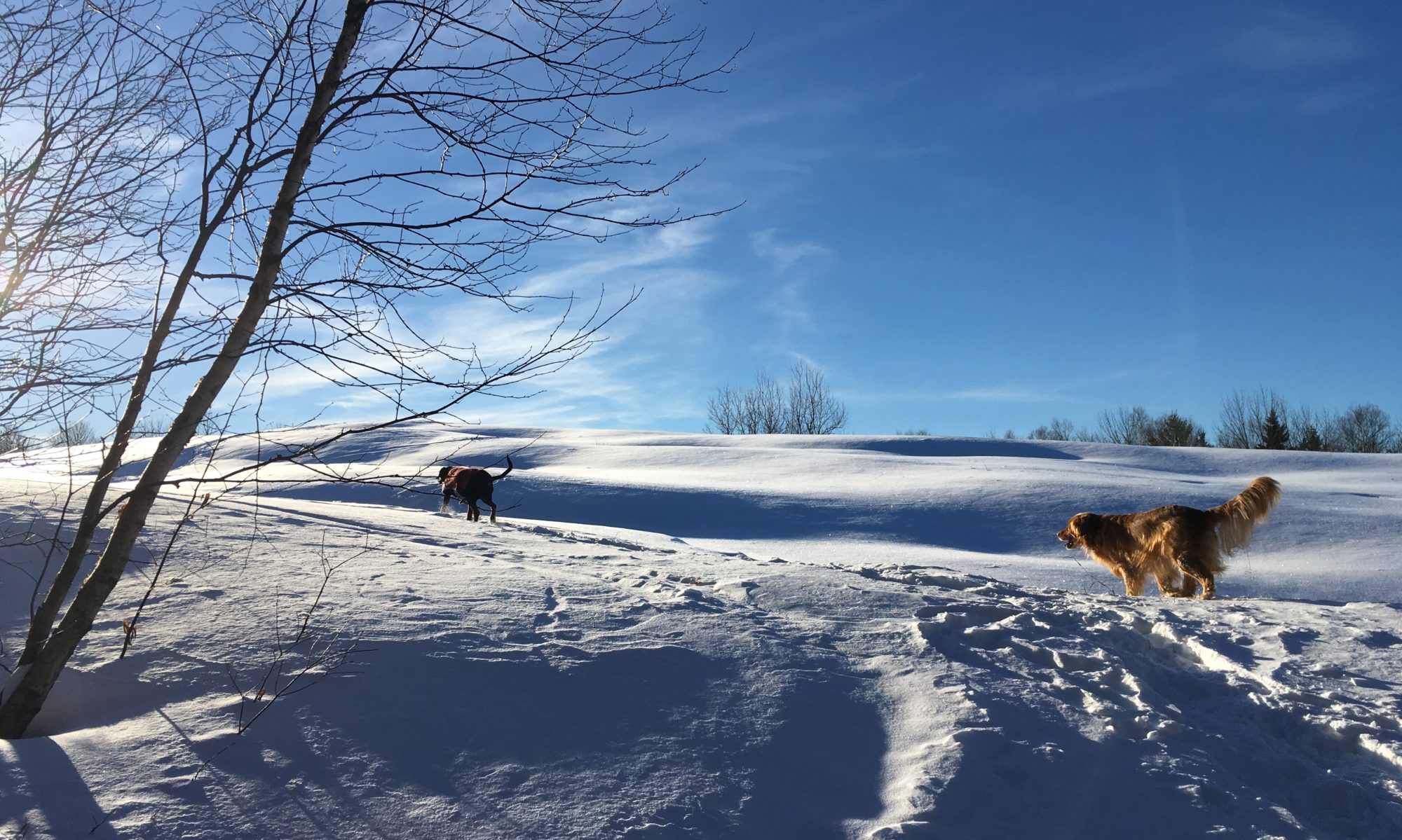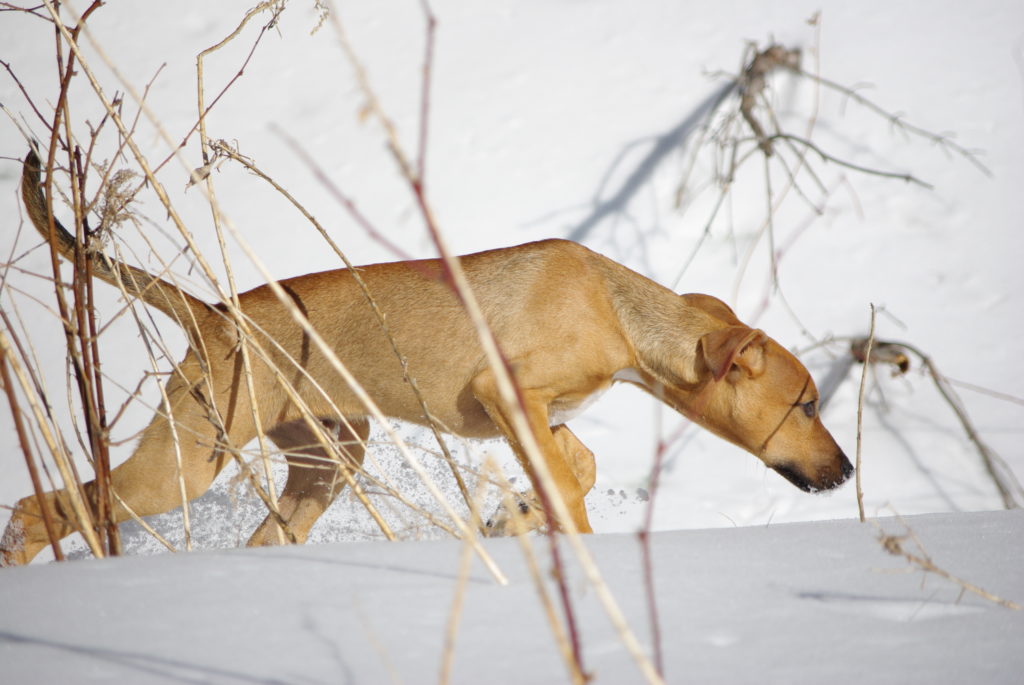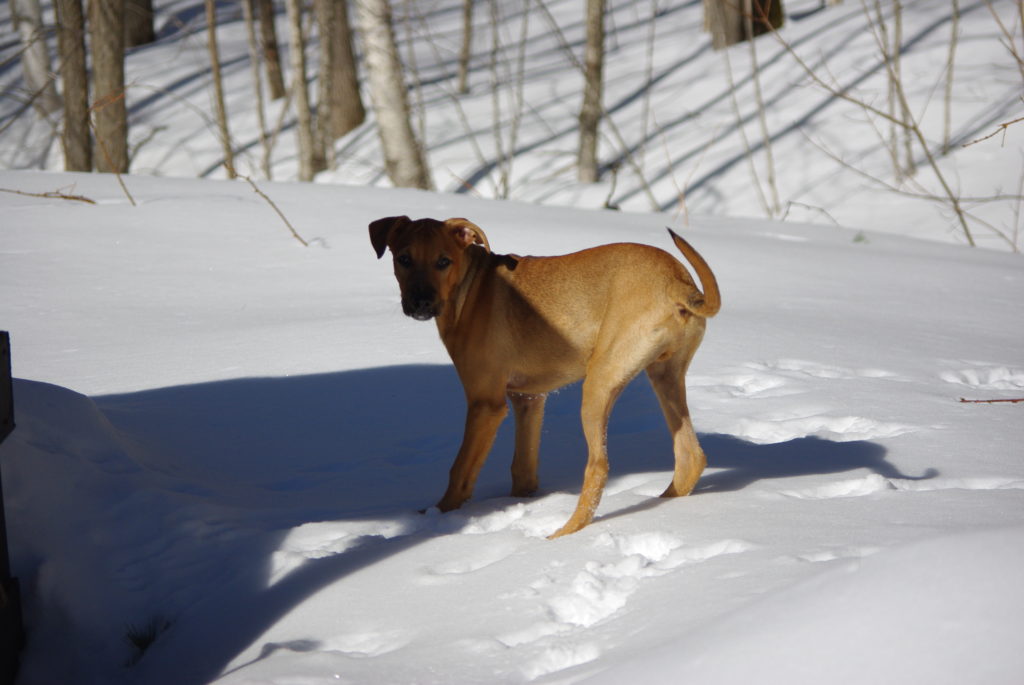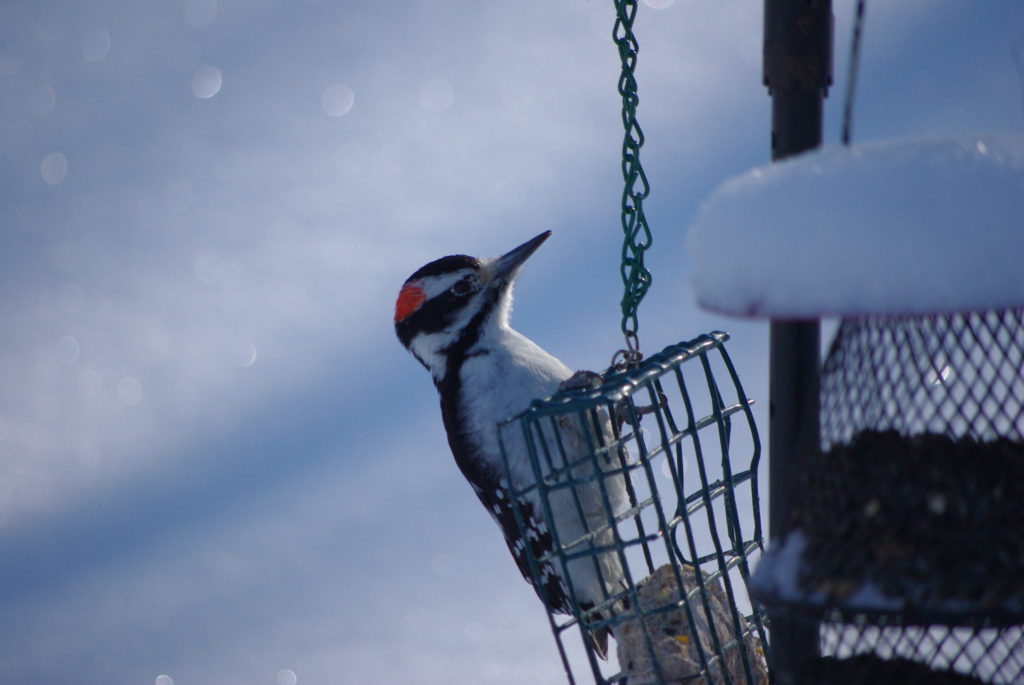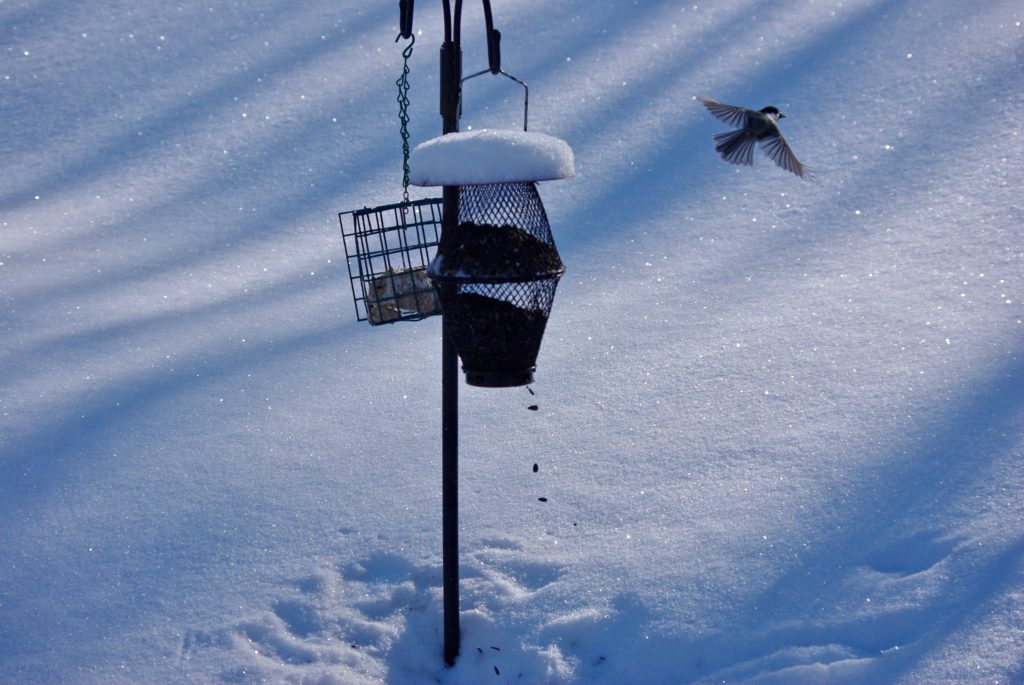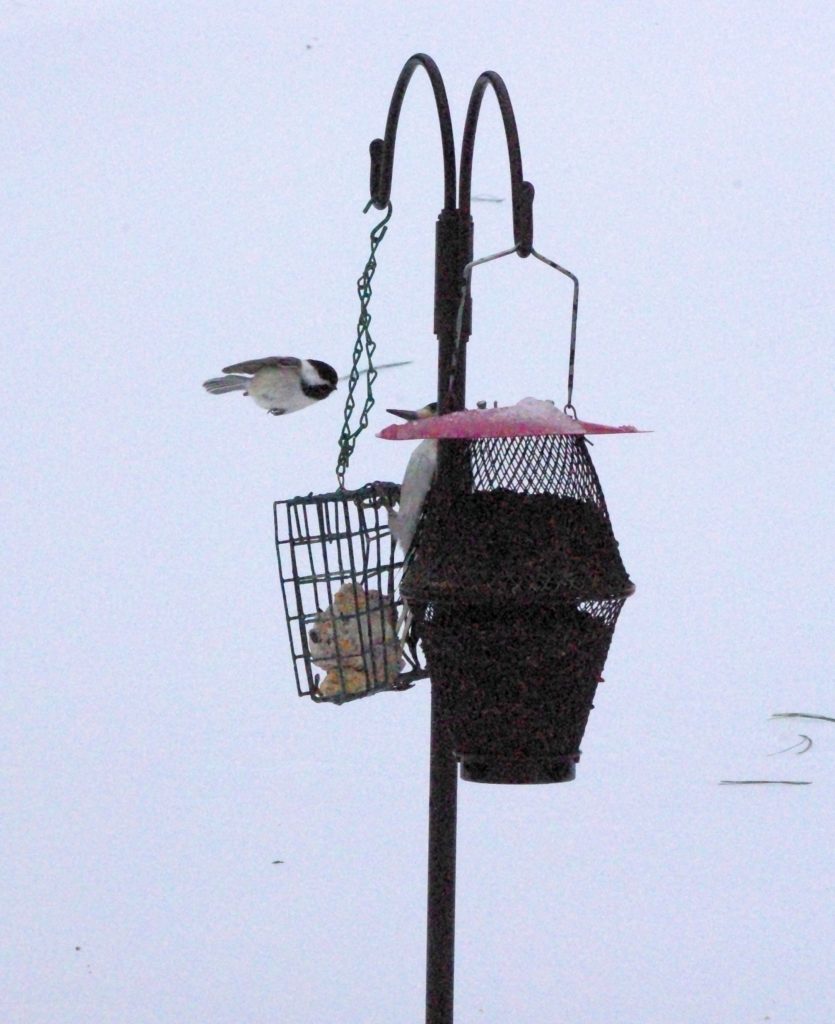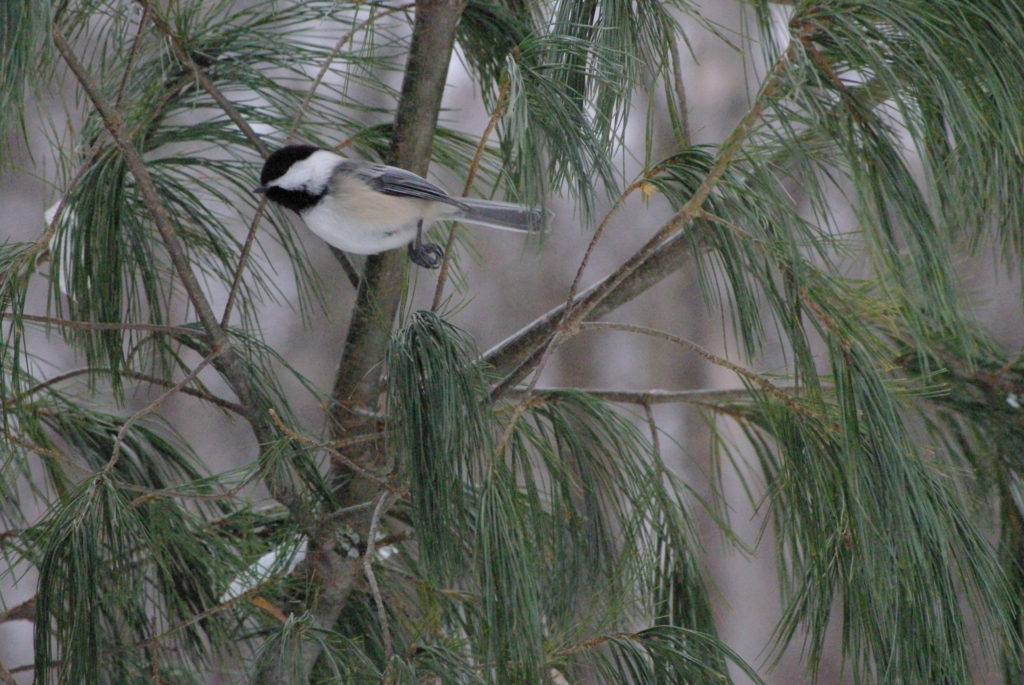I set out this afternoon to shoot more bird photos with different camera settings. However, Milu really needed some outdoor time so I took him with me. Needless to say, he scared the birds off while running around in the back. Milu has discovered a big new world and decided to roam around in the woods. Fortunately, I had snow shoes on and managed to call him back when it counted. The best photos I got today were of Milu, although I did get a few decent bird shots. Today’s settings were ISO 200 and aperature setting of F/4.0 (1/2 second shutter speed). The photos are definitely crisper and capture more detail, but I’m not sure yet how I feel about the blurred context. It really depends on how close in I’m zooming (I think). Still, these are some great shots of Milu.
Today’s Test Shots
Experimentation with the new camera continues. This morning, I spent about fifteen minutes taking more backyard birding shots. I had planned to increase the ISO rating since yesterday’s photos were a little darker than I wanted, but it’s sunnier out today so I stuck with the 400 ISO, for now. I’ll adjust the ISO later in the day to see how it affects the results.
Rediscovering My Love of Photography
I have loved photography ever since being stationed in Germany during the 1990’s. In recent years, since moving to Vermont, my favorite photography subject has been wildlife. I’m surrounded by great wildlife sightings at my home in Pomfret at all times of the year.
I didn’t join the digital age, however, until somewhat recently when I bought a Panasonic Lumix about six or seven years ago. It was an excellent pocket camera, even for photographing wildlife, but unfortunately the camera broke and it wasn’t worth spending the money to get it fixed.
Fast forward to this past weekend. It was my birthday this past Saturday, February 23rd, and my partner Meg bought me a Pentax K2000 to quench my photography thirst. Since the weekend, I’ve been getting to know the camera, experimenting with different settings and lenses. I’m psyched to continue the learning process.
Today, I made a helpful discovery for wildlife photography – that I can eliminate a lot of “digital noise” on the front end of the process by adjusting the ISO level. I started with the default ISO of 3200, but that setting produced a lot of noise and made the photos look grainy (a few of the photos below were taken at 3200 ISO). I ratcheted the ISO down to 400 which made a big improvement in clarity and the feel I wanted for wildlife photography – a sharp image of the subject and less sharpness for the surrounding context of the photo. See below for a few of the shots I took earlier today.
Two Tales of Leadership
In my last duty assignment in the U.S. Army, I served as the Brigade Adjutant (S-1) of the 94th Air Defense Brigade while stationed at Rhine Ordnance Barracks in Kaiserslautern, Germany. My job generally included overseeing human resources and personnel assignments for the units within the brigade, which at the time numbered about 1,500 people. I learned a valuable leadership lesson in my unique vantage point observing the commanders of each battalion within the brigade. I learned that there are basically two kinds of leaders, and not just in the military.
One kind of leader views his or her people as finite resources that will perform only up to a certain level; that each person within the organization has a ceiling of performance and that the job of the leader is to motivate his or her subordinates to reach the ceiling or get as close to it as possible, often by whatever means is necessary. Winning is important. The tendency, however, is to view people as commodities and that they are often expendable, either through normal attrition, rotation or replacement. The morale in these kinds of units is typically mixed. The morale is sometimes high because these kinds of units often excel at evaluations and competitions. The downside, however, is that there’s often a culture of fear. Subordinates will generally go far for their leader, but less out of true loyalty than out of pressure of being fired or replaced. The saving grace for many is that the unit assignment is only a few years long.
The other kind of leader is more relational and views his or her people as people; that each person within the organization has some unknown level of performance. The performance level could be lower or higher than anyone could possibly expect. I’ve seen people in these kinds of units do things they never thought they could do. Winning is less important, however. In competitions, the unit might place a distance second or even third to the first kind of unit. When progress is made, it’s often slower in comparison. But, what I observed about this second kind of unit is that the people would follow their leader anywhere and that there’s a certain steadiness and depth to the organization. Loyalty is created out of mutual and personal respect, not extracted.
I often think about these two basic schools of leadership in the context of government. Frequent elections tend to more often create the first kind of leadership environment than the second. It’s a short-term style of leadership. Putting points on the board quickly takes precedent over developing a more nurturing sense of leadership that would otherwise establish a deeper and arguably more effective culture within government. Sadly, I too hear government employees talk about “riding it out” until the next election, or retirement.
Reducing Barriers to Obtaining Health Care Records
In the 2016 legislative session, Representative Teo Zagar introduced H.554 on my behalf after I wrote to him explaining how costly it would be to obtain a copy of my health care records. At the time Teo and I corresponded (December 2015), a copy of my records would have cost $438, which is what’s allowed by statute ($5.00 flat fee or $.50 per page, whichever is higher). I hope the bill will get picked up this coming session and reintroduced in the House Health Care Committee.
There’s a strong argument that consumers should be able to obtain a copy of their own records for free. In the bill I drafted, I suggested that consumers be allowed one free copy of their records per year. Even if a personal copy of one’s records isn’t made available for free, the cost should be reduced from $.50 per page to a rate more comparable to the actual cost that it takes to produce the records.
The $.50 per page copy fee is substantially more than commercial printing costs which are around $.10 per page and while providing one free copy may seem like an administrative burden and an extra cost on providers, it would certainly benefit the public at large for consumers to have easier access to their own medical records. The legislature may want to emulate Vermont Public Records law by allowing for the first 30 minutes of labor to be free and to require that records be produced at actual cost.
Similar to public records law, any time there are cost barriers placed in front of consumers, these barriers make health care generally less transparent.
